CIMIC Messenger in 2025
Dear CIMIC Community of Int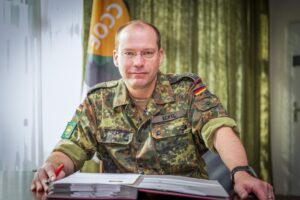 erest,
erest,
We find ourselves at a defining moment for NATO and its partners. The war in Europe – directly in the neighborhood and other crisis further at the Alliance’s borders, persistent hybrid threats from adversaries like Russia, the rising pacific challenges and the significant recalibration of our security architecture, as most recently underscored at the NATO Summit in The Hague, demand a deeper, more integrated civil-military approach than ever before. These complex realities reinforce the criticality of Civil-Military Cooperation (CIMIC) as a military joint function of strategic relevance. The activation and resilience of the civil societies and all their capacities are the factors to build up a holistic and integrated defence approach.
To remain relevant and effective, we must advance CIMIC beyond doctrine and concept. The further capability development of CIMIC as a military joint function, integrated into all planning levels and aligned with Multi-Domain Operations, is essential. Operationalizing CIMIC in practice means embedding Civil Factor Integration and Civil-Military Interaction in the day-to-day work of our commands, units, and partners. It also means equipping our personnel with the analytical tools, training, and mindset needed to drive coordinated civil-military efforts in complex environments.
In this edition of the CIMIC Messenger, you will find a powerful reflection of how our community is rising to meet these demands. From examining the conceptual dilemma of CIMIC’s role within NATO, to advancing joint training with U.S. Civil Affairs and supporting Ukraine’s CIMIC development, we continue to adapt, innovate, and lead. The upcoming Annual CIMIC Foresight Conference 2025 aims to move us “From Foresight to Action”, reinforcing doctrine and concepts with real-world implementation. Likewise, the EU-NATO CIMIC Course marks a substantial advance in harmonizing civil-military training across institutional frameworks. The interaction and mutual exchange of expertise and requirements with our partners and esteemed members of the civil community of interest, such as civil organisations and academia, is pivotal for the essence of civil -military cooperation.
Whether you’re reading about our SceneLab workshop with students from Leiden University, the integration of AI into training, or our “Beyond the Classroom” webinars, one message is clear: CIMIC must continue evolving in both mindset and mission to meet the needs of a volatile strategic environment.
Thank you for your continued dedication to advancing civil-military cooperation. Together, we ensure that NATO remains not only ready, but resilient and responsive in the face of 21st-century security challenges.
Together Stronger
Andreas Eckel
Director, Civil-Military Cooperation Centre of Excellence (CCOE)
The Hague, July 2025
Topics in this CIMIC Messenger
- “1Day@CCOE” Event
- Annual CIMIC Forsight Conference 2025
- CIMIC-related publications – an update
- Annual Civil-Military Cooperation (CIMIC) Discipline Conference (ADC)
- The acaCIMICs Experience – Where Military Precision Meets Academic Insight for Tomorrow’s Challenges
- The CIMIC Dilemma: Joint Function or Activity
- Advancing Interoperability: CCOE’s Strategic Engagements with U.S. Civil Affairs
- CCOE’s “Beyond the Classroom” Webinar Series
- Set up the EU-NATO CIMIC course
- Support to UKR CIMIC
- Support to the NATO CIMIC Orientation Course (NCOC) at the NATO School Oberammergau
- Training & Education at the CCOE: Enabling CIMIC Excellence Across NATO and Beyond
"1Day@CCOE" Event
On the 15th of April 2025, the Civil-Military Cooperation Centre of Excellence (CCOE) opened its doors to 30 students from Leiden University for the inaugural “1Day@CCOE” event, a day that proved not only informative and inspiring for both participants and hosts. This initiative results from a growing academic partnership between the NATO-accredited CCOE and Leiden University, underscoring the mutual commitment to fostering knowledge exchange and professional development. Welcoming the students, the CCOE underscored the Centre’s commitment to engage with the next generation of professionals in security and international cooperation. The students’ curiosity and enthusiasm set the tone for a day dedicated to learning, exchanging ideas, and forging new connections between academia and CIMIC. The opening discussions highlighted the evolving global security landscape and the critical role that CIMIC plays in responding to complex, cross-cutting challenges. By sharing real-world insights and operational experiences, CCOE staff aimed to demystify the field for students and encourage them to envision and share their potential contributions.
SceneLab Workshop: Advancing CIMIC Future Readiness through Scenario Development
A central feature of the day was the SceneLab Workshop, a dynamic, hands-on activity designed to immerse students in the practical application of CIMIC principles. Participants were introduced to the exercise through an engaging video-comic, which set the scene by presenting them with a mission from a commander. As CIMIC planners, they were asked to develop forward-looking scenarios addressing NATO strategic issues such as Artificial Intelligence-driven disinformation, environmental disasters and mass movement of people. This interactive format not only encouraged critical reflection on the complexities of CIMIC but also empowered the students to think critically about the role of NATO and the military in the future.
What truly set the event apart was the spirit of genuine dialogue. Throughout the day, students and staff engaged in open conversations, sharing experiences, asking questions, and listening curiously to one another. These exchanges highlighted the immense value of inviting fresh voices into the conversation. The students’ questions and ideas served as a potent reminder that the future of CIMIC depends on our ability to engage with the younger generation and influence the mindset of future leaders and policy-makers. The closing session focused on career and internship opportunities at CCOE, sparking enthusiastic interest among participants and reaffirming CCOE’s commitment to welcoming new talents.
Reflections and Way Forward: Building Bridges for the Future
Reflecting on the day, it is clear that “1Day@CCOE” achieved far more than its initial objectives. It fostered a vibrant exchange of knowledge, inspired new ways of thinking, and strengthened the bridge between academia and operational practice. Most importantly, it reaffirmed that meaningful engagement with students is not just beneficial but essential. By listening to young voices and embracing their perspectives, the Centre ensures it remains adaptable, forward-looking, and responsive to the evolving demands of civil society.
The success of this event sets a strong foundation for future collaboration. As we look ahead, the CCOE is committed to advancing the “1Day@CCOE” initiative and extending opportunities to more universities and students. By broadening academic partnerships, the Centre aims to foster an even richer environment for dialogue, learning, and innovation to empower the next generation.
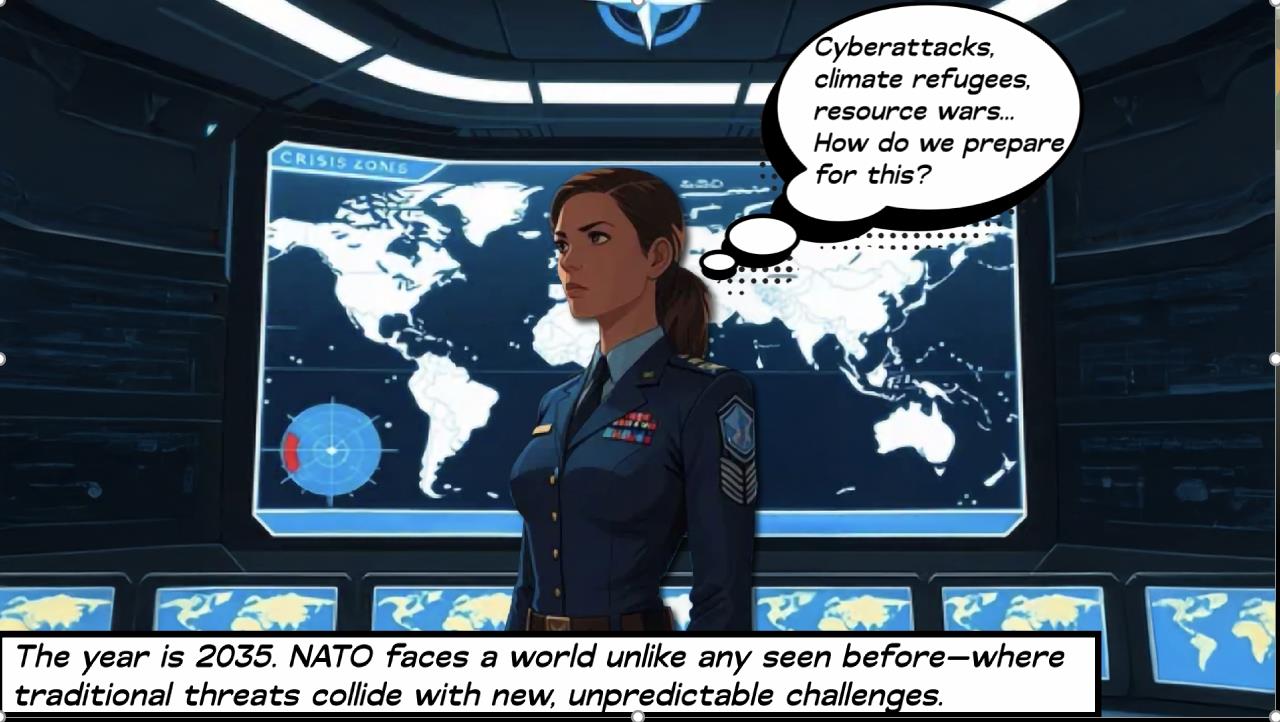
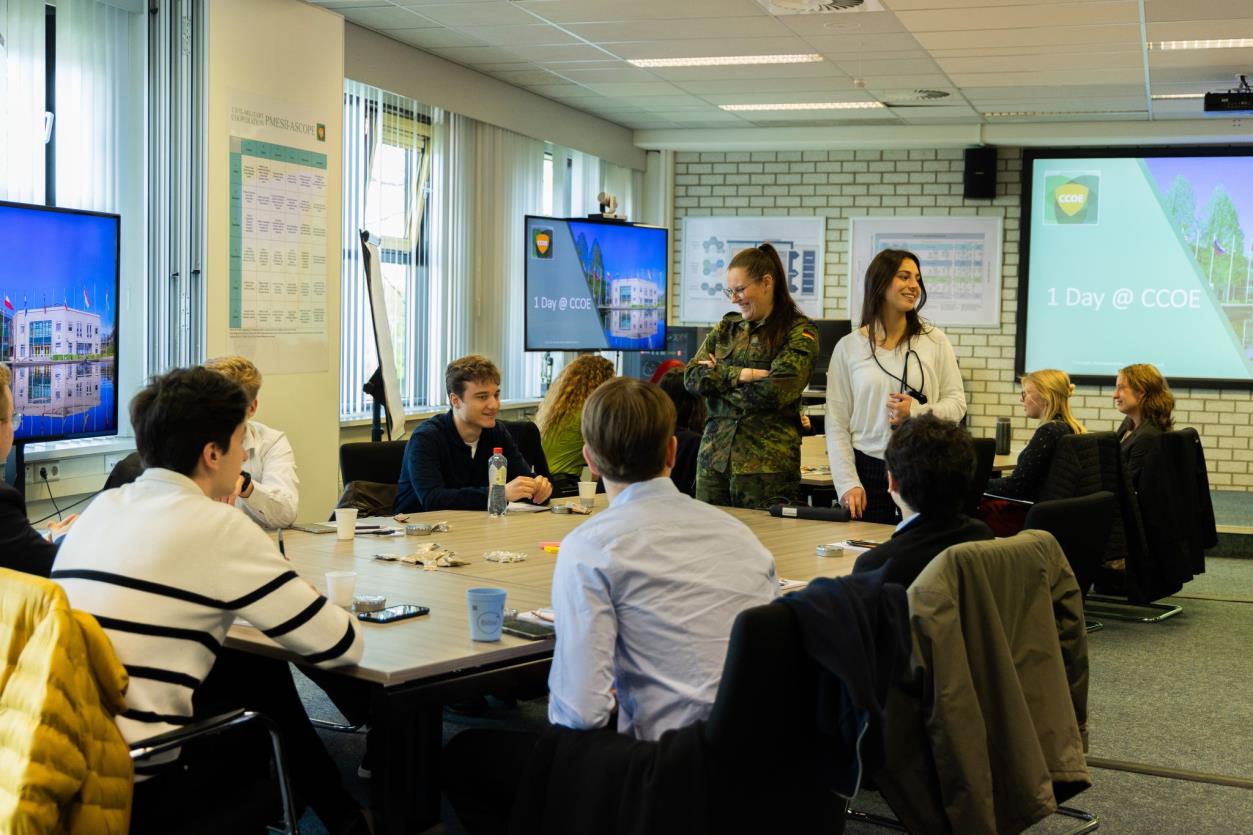
Annual CIMIC Forsight Conference 2025
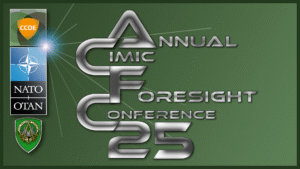 From 15 to 19 September 2025, the NATO accredited CCOE, in strong cooperation with SHAPE J9, will co-host the Annual CIMIC Foresight Conference at the Majoor Jan Linzel Complex (MJLC) in The Hague. Continuing the momentum of previous years, this event brings together military professionals, civilian experts, policy- and decision-makers, and academics to shape the future of CIMIC. Under the theme “From Foresight to Action,” the 2025 edition marks a strategic shift from identifying future challenges to developing concrete solutions and capabilities. Building on the firm foundation of the 2024 conference, this year’s event aims to turn strategic vision into operational reality.
From 15 to 19 September 2025, the NATO accredited CCOE, in strong cooperation with SHAPE J9, will co-host the Annual CIMIC Foresight Conference at the Majoor Jan Linzel Complex (MJLC) in The Hague. Continuing the momentum of previous years, this event brings together military professionals, civilian experts, policy- and decision-makers, and academics to shape the future of CIMIC. Under the theme “From Foresight to Action,” the 2025 edition marks a strategic shift from identifying future challenges to developing concrete solutions and capabilities. Building on the firm foundation of the 2024 conference, this year’s event aims to turn strategic vision into operational reality.
Over five days, participants will explore a wide range of topics central to the evolution of CIMIC. A key focus will be developing future CIMIC capabilities that align with the changing nature of conflict and crisis response. As NATO and partner nations face increasingly complex environments, there is a growing need to modernize doctrines, tools, and training approaches. A significant portion of the conference will support the development of new Allied Joint Publications (AJP) and update doctrines, reflecting the latest thinking and best practices in the field.
The conference will also highlight CIMIC’s role in Human Security, focusing on how civil- military efforts protect civilians, uphold human rights, and support fragile societies. Additionally, it will address the use of AI in CIMIC, exploring its potential for improved planning and coordination, alongside its ethical challenges.
Domestic CIMIC is becoming increasingly important as societies face complex challenges like hybrid threats and natural disasters. To succeed, it requires the active involvement of all partners military, government, and private sector working together through clear communication, mutual understanding, and joint preparedness. This collaborative approach can only ensure a unified and effective response in a multidomain environment.
Beyond the formal sessions, the CIMIC Foresight Conference offers a dynamic platform for networking, knowledge-sharing, and collaboration. It brings together voices from the military, government agencies, humanitarian organisations, academia, and the private sector, fostering open dialogue and creating meaningful partnerships. Attendees will engage with top-tier speakers and subject-matter experts and have the opportunity to actively shape CIMIC’s future. By participating, they contribute directly to NATO’s strategic development, gain early insight into emerging trends, and build lasting relationships across sectors. Whether a seasoned CIMIC professional or new to the field, every participant drives innovation and progress.
In addition to the CIMIC Foresight Conference, CCOE is preparing for several other key activities in the second half of 2025. These include hosting the Summer School for the OTH Regensburg, one of CCOE’s academic partners, as well as participating in the Simulation Exercise of the HS Bund to support the training of future administrative staff of the German Armed Forces. The CCOE will also be present at the CIMIC Conference in Naples, continuing to expand dialogue and cooperation across NATO’s institutions.
The Annual CIMIC Foresight Conference 2025 promises to be a milestone event in advancing the future of civil-military cooperation. For registration details and further information, please visit: Annual CIMIC Foresight Conference 2025 – CIMIC COE.
CIMIC related publications – an update
MC 411/3
In January 2025, a dedicated team from the CCOE undertook a thorough review and revision of the MC 0411, which was in the process of being updated. Our objective was to create a solid foundation for this vital document. After several productive discussions and collaboration with key stakeholders at SHAPE, ACO, and ACT, we successfully submitted the revised document to SHAPE J9. On June 16, a delegation from the CCOE had the opportunity to present the document and its amendments to representatives from 32 allied partners at NATO HQ IMS. We are optimistic that the document will be published later this year, marking an important step forward in our collective efforts.
AJP 3.19
After nearly two years of standstill, we are excited to announce the publication of AJP 3.19 – the foundational document for CIMIC in NATO. The main challenge was reaching consensus on the EU and NATO procedures outlined in the document. However, we made a strategic decision to remove this contentious paragraph to ensure the progression of our doctrine. Working closely with our partners in ACO and ACT, we achieved the necessary ratifications, and now we proudly have AJP 3.19 CIMIC in our possession. But we’re not stopping here: while this process unfolded, the world has continued to evolve. We are already embarking on the revision of this crucial doctrine, and we are committed to developing a Level 1 doctrine for CIMIC – an AJP 9.
CIMIC Handbook
The CIMIC Handbook was last revised in July of last year, and we are pleased to report that the current version is fully aligned with our existing doctrinal landscape. However, as the world continues to evolve, it is imperative that we keep pace. We are seeing the emergence of critical topics such as domestic CIMIC, collaboration with the private sector, and the integration of AI. The CCOE is set to initiate the next revision of the Handbook in November this year, ensuring that we remain attuned to the dynamic changes in the security environment.
CIMIC Tactical Planning Guide
The CCOE is set to establish a comprehensive CIMIC Tactical Planning Guide (CTPG) that will serve as an essential manual for all tactical CIMIC Land units. This guide will empower these units to effectively align their planning efforts with APP 28. It will seamlessly integrate with the operational CIMIC doctrine (AJP 3.19 and CFPG), which clearly defines the crucial role CIMIC plays in the NATO Operations Planning Process across all types of operations. The CFPG is firmly rooted in AJP 3.19 and MC 411/2.
In the current CIMIC publication and manual landscape, there is a notable gap when it comes to tactical publications or manuals. While the existing AM 86-1-1 (CIMIC Tactics, Techniques, and Procedures) does provide some guidance, it unfortunately blends tactical, operational, and strategic levels, creating confusion. As outlined in APP 28, there is currently no dedicated tactical doctrine available to assist commanders and G9 Staff in clearly defining their contributions to the land tactical planning process.
The forthcoming CIMIC tactical planning guide will comprehensively outline the tactical planning process, including critical CIMIC inputs and outputs, as well as the essential activities required at every stage, all in alignment with APP 28 tactical planning for land forces. This guide will be a vital resource for enhancing the effectiveness of CIMIC operations.
Tactical tabletop tool
The CCOE is thrilled to propel its wargaming initiatives forward! Following the successful establishment of WISE AEGIS and ANALYSIA, we are now keenly focusing on tactical-level advancements, developing a robust tool specifically crafted for field practitioners. Prepare to significantly enhance your tactical capabilities!
Introducing the CIMIC Tactical Table Top Tool: a scalable, terrain-agnostic solution designed to elevate the understanding, planning, and rehearsal of Civil-Military Cooperation (CIMIC) within the NATO Corps’ land tactical environment. Built on a versatile battlespace layout, this board-game accommodates a wide range of operational themes and tactical activities.
The CIMIC Tactical Table Top Tool equips both trainers and planners with a dynamic platform to visualize, rehearse, and assess the vital role of CIMIC in NATO land operations. It guarantees that CIMIC is not only visible but also a fundamental element of the operational planning and execution cycle. Get ready to take command of your tactical operations!
Annual CIMIC Discipline Conference
From June 10 to 12, 2025, the Annual CIMIC Discipline Conference (ADC) took place in city of Rovaniemi, Finland. Hosted by the Finnish Defence Forces International Centre (FINCENT), this year’s event once again brought together experts and key players from NATO and its partner nations to collaborate on the future of three disciplines: CIMIC, Integrated Security and Building Integrity.
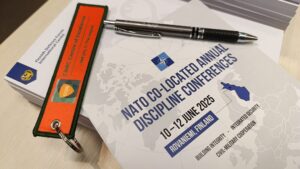
As part of the co-located conference setup [FINCENT, CCOE, The Centre for Integrity in the Defence Sector (CIDS), and this year as guests – in 2026 as full participant – The Nordic Centre for Gender in Military Operations (NCGM)], the CCOE shared updates on its ongoing work across doctrine development, training, education, and exercises. The team also presented its main priorities for 2025 and 2026, emphasizing innovation and alignment with NATO’s operational requirements.
Among the highlights were updates to CCOE training courses, advancements in serious gaming, and efforts to provide more dynamic learning experiences beyond the classroom. The CCOE discussed its review of the NATO CIMIC Orientation Course (NCOC) intended for a non-CIMIC training audience and its contributions to major NATO and Sponsoring Nation exercises. The team also explored how the concept of Multi-Domain Operations (MDO) is being incorporated into CIMIC training.
Collaboration remained a central theme, with the CCOE underlining the value of working closely with other training and education providers and disciplines.
In this year’s conference the introduction of a new CIMIC capability in Analysis and Assessment was showcased through an innovative wargame called ANALYSIA. Designed to support more effective planning and decision-making, this new tool allows users to simulate complex scenarios and apply structured analytical methods, closely aligning with NATO’s MDO principles. During the conference, the CCOE also successfully implemented its Instructor Support Plan, aimed at mapping and coordinating support for subject matter experts (SMEs) and instructors across both CCOE-led courses and those offered by other CIMIC Education and Training Facilities (ETFs).
Finally CCOE played a key role in shaping the upcoming Discipline Alignment Plan (DAP), helping to steer the direction of CIMIC education and training in the years ahead. These contributions are expected to enhance interoperability across NATO’s CIMIC Training and Education landscape.
See you all back in 2026 in the ADC at that time in Sweden!
Bridging Worlds: The acaCIMICs Experience – Where Military Precision Meets Academic Insight for Tomorrow’s Challenges

On May 14–15, 2025, the acaCIMICs initiative unfolded as a dynamic, hybrid forum – a meeting of minds and a fusion of cultures. Military strategists, academic pioneers, and tech visionaries converged, blending the rigours of military discipline with the curiosity and creativity of academia. With 30 in-person participants and over 40 joining online, the event in The Hague at the NATO accredited CCOE sparked a new era of collaborative innovation, setting a precedent for how military and academic communities can speak the same language and work toward shared goals.
Kicking off with a visionary panel that reimagined the relationship between the military and academic spheres, the discussions did not focus on differences. Still, they centred on shared values: trust, understanding, and a culture of co-creation. These themes became the foundation for all discussions, signalling a shift from siloed expertise to integrated, cross-disciplinary collaboration. The explicit aim was to dissolve barriers between theory and practice and build a shared vocabulary for security and defence.
Four Pillars of Tomorrow’s Cooperation
The programme was structured around four innovative tracks, each designed to catalyse breakthroughs at the intersection of military operations and academic research:
AI & New Technology: The Digital Frontier
Artificial intelligence and next-generation technologies are reshaping the defence landscape. This session demonstrated how academic research and practical innovation can merge to create smarter, more resilient systems. Highlights included AI-driven simulations, immersive wargaming, ethical explorations of large language models, and no-code AI tools that democratise access to cutting-edge solutions. The result? A more inclusive, agile, and interconnected approach to security.
Wargaming: The Art of Anticipation
Wargaming has evolved from a tactical exercise to a critical tool for navigating uncertainty. The session explored human geography-infused planning, virtual reality-enhanced scenarios, and serious games targeting disinformation. By blending academic methodologies with real-world experience, participants discovered how to craft wargames that are as educational as they are strategic.
Simulations & Exercises: Beyond Training
Simulations have transcended their traditional role, becoming essential for building resilience and coordination. This session showcased immersive technologies, data-driven models, and real-world experiments that challenge old assumptions and foster new partnerships and insights. The focus was on agility – preparing both civil and military actors for the unexpected.
Case Studies: Lessons from the Field
Real-world examples illuminated the power of collaboration. From exploring legitimacy dynamics in CIMIC environments to initiatives like the Green Helmets for sustainable operations, the session highlighted how integrating new technologies and interdisciplinary approaches can address complex, evolving challenges. These case studies offered practical insights for policymakers and strategists alike.
A special session by the NATO Science & Technology Organisation (STO) outlined the structures and priorities for Alliance cooperation. This presentation inspired fresh ideas for joint projects and knowledge-sharing, reinforcing the event’s mission to bridge worlds and spark innovation. acaCIMICs concluded with a vibrant roundtable, where participants reflected on the sessions and mapped out future opportunities. Connections were forged, ideas were exchanged, and the enthusiasm was palpable. The positive feedback and anticipation for the next acaCIMICs in 2026 underscored the event’s success.
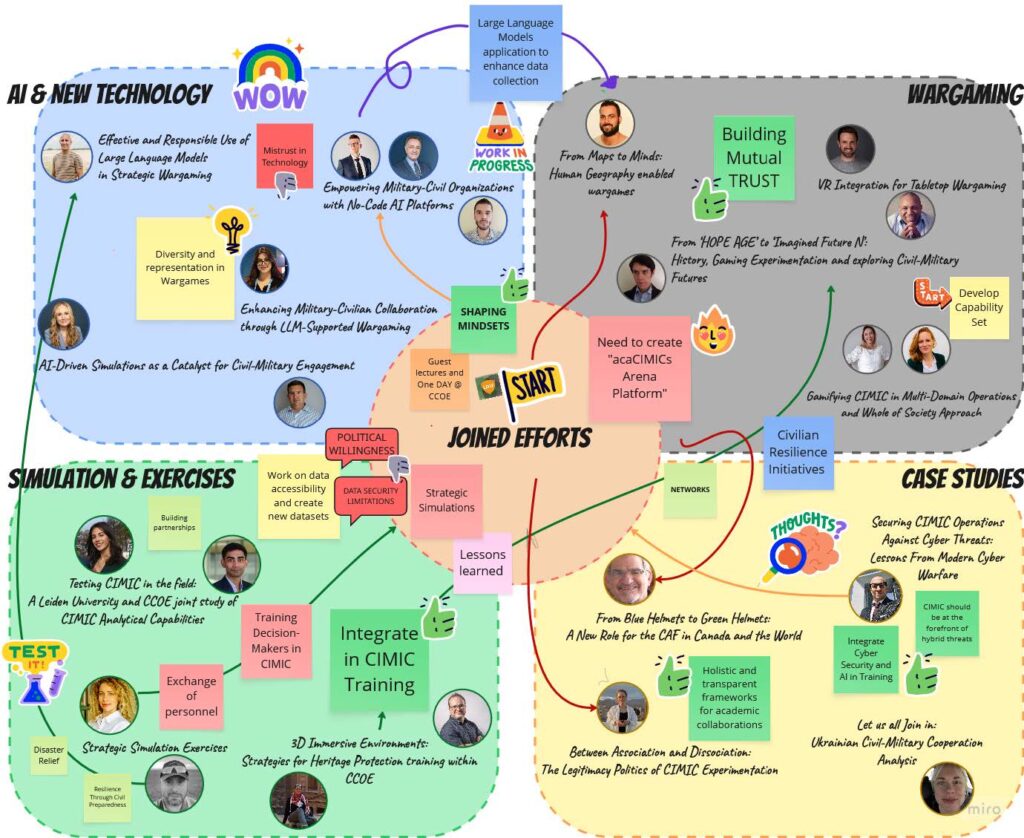
Conclusion: A New Chapter in Civil-Military Cooperation
“acaCIMICs – Collaborative Innovation for Future Readiness” was more than an event – it was a milestone. By fostering dialogue, sparking innovation, and building bridges between military and academic communities, acaCIMICs has set the stage for a new chapter in strategic
readiness. The forthcoming “acaCIMICs Vol I,” published online in late June, will capture the event’s insights, innovations, and collaborative spirit, ensuring that its impact resonates across the civil-military cooperation community for years to come.
The CIMIC Dilemma: Joint Function or Activity
Summary
The understanding of the role of CIMIC within NATO presents a fundamental dilemma: Is CIMIC an independent military joint function following manoeuvre, fires and information to create (converging) effects, or is it merely a supporting activity? This ambiguity leads to varying interpretations, operational inconsistencies, and structural misunderstandings within the armed forces and their interactions with civilian partners. This article reflects the causes and effects of this dilemma, explores internal and external perspectives on CIMIC, and situates its role within current security policy frameworks, such as the Comprehensive Approach, MDO, and Resilience through Civil Preparedness (RtCP). Finally, it recommends establishing a clear doctrinal foundation and enhancing operational integration.
Introduction
NATO’s security landscape is characterized by asymmetric threats, hybrid conflicts, deterrence & collective defence and a growing emphasis on societal resilience. In this context, as a whole-society/alliance approach is key, civil-military cooperation is becoming increasingly important. However, how CIMIC is structured and functionally integrated within NATO remains unclear: Is it a fundamental component of military planning and core activities or simply an auxiliary feature? This question relates to essential aspects of military organisation, effectiveness, and leadership.
The Conceptual Dilemma
According to MC 0411/3 and AJP-3.19, CIMIC is a military joint function. It consists of two core activities: Civil Factor Integration (CFI) and Civil-Military Interaction (CMI). Both activities are intended to serve as systematic and integrative elements in military planning, operations and activities. However, CIMIC is partly limited to isolated measures, especially by decision- makers with experience in stabilisation operations. This narrow perspective underestimates the strategic importance of CIMIC and hinders its integration into planning processes, particularly regarding civilian resilience.
Internal Perspective: Implementation Gaps and Insularity
Despite clear doctrinal guidelines, there is a lack of consistent application in practice and holistic understanding. CIMIC staffs often focus on their tools, procedures and required products without integrating their roles and expertise into the broader context of other military joint functions, such as intelligence and sustainment. This insular approach can lead to institutional isolation. Moreover, many military planners outside the CIMIC community lack formal training in CIMIC, resulting in misunderstanding the utility of CIMIC and missed opportunities to utilise CFI and CMI as analytical and planning tools, especially when assessing the implications of the seven Baseline Requirements (BLRs) for civil preparedness and the implications of key civil factors of the operating environment on the overall military operation. Implementing interdisciplinary training as well as the further professionalsiation of the planning and the analysis and assessment capability could be a constructive solution to this issue.
External Perspective: Perception and Misunderstandings
CIMIC is often viewed as a “soft” or secondary tool by civilian partners and other military actors. However, it is doctrinally integrated into all NATO core tasks, which include deterrence and defence, crisis prevention and management, and cooperative security. CIMIC is designed to serve as a connecting element within a comprehensive approach to all NATO core tasks. Non-military actors (still) frequently associate CIMIC primarily with humanitarian aid. Civil- military coordination is essential for the effective functioning of state institutions and services, critical infrastructure, and mutual civil and military support during peacetime and especially in crises and conflict. CIMIC, as a joint function, ensures coordination among government authorities, the private sector, and international organizations by promoting structured collaboration.
CIMIC in the Context of Current Concepts
NATO doctrine (AJP-01) and the Alliance Concept for MDO emphasize the importance of synchronizing military and non-military activities. CIMIC, with its focus on civil factors and actors, offers established interfaces, networks, and procedures that contribute to the integration of operational mechanisms. Particularly at the strategic level, CIMIC facilitates detailed impact analyses of the seven BLRs. This role should be more strongly emphasized in discussions about MDO and within civil-military interaction and coordination frameworks.
Conclusion
According to NATO doctrine, CIMIC is a joint function of strategic importance. The common misunderstanding of CIMIC as merely an auxiliary activity arises more from poor implementation exercises and operations, a lack of mindset, and insufficient training than conceptual gaps.
Recommendations:
- Embed CFI and CMI into non-CIMIC training, doctrine, and communication.
- Integrate CIMIC into all planning levels, including the Comprehensive Operations Planning Directive (COPD), Joint Operations Planning Group (JOPG), and MDO design.
- Expand joint training with non-military partners using relevant scenarios.
- Exploit further the utility of CIMIC analysis and assessment capabilities.
- Include explicit references to AJP-01 and other relevant documents to ensure a comprehensive understanding and implementation of CIMIC principles.
CCOE’s “Beyond the Classroom” Webinar Series:
The CCOE is pushing traditional training boundaries with its ongoing “Beyond the Classroom” webinar series, a forward-thinking initiative designed to expand the accessibility, depth, and impact of CIMIC education across NATO and partner nations.
Launched as part of CCOE’s broader strategy to modernize learning, the series offers flexible, interactive sessions that dive into real-world civil-military cooperation challenges. By bringing together experts, practitioners, and students in a virtual environment, these webinars complement formal training and provide a dynamic space for discussion, reflection, and innovation.
Each session explores current operational topics, emerging trends, and lessons learned from recent missions and exercises. The webinars aim to keep participants at the forefront of strategic thinking and practical solutions.
Two iterations of the CCOE Seminars – Beyond the Classroom were successfully delivered in the first half of 2025:
- Unifying Forces: Civil Affairs and CIMIC
- Resilience vs Resistance
For the second half of 2025, the following seminars are scheduled in resp. October and December:
- Artificial Intelligence at the Crossroads: Evil or Opportunity?
- Climate Change Uncovered
The “Beyond the Classroom” approach aligns with CCOE’s mission to foster interoperability and build a robust community of CIMIC professionals. By offering timely, relevant content in an accessible format, CCOE continues to support the professional development of CIMIC personnel and its community of interest, enhance institutional knowledge, and strengthen NATO’s comprehensive approach to security.
Advancing Interoperability: CCOE’s Strategic Engagements with U.S. Civil Affairs
Between December 2024 and June 2025, the CCOE continued to deepen its cooperation with the U.S. Civil Affairs (CA) community through a series of impactful training activities, strategic engagements, and multinational forums. This sustained collaboration not only reinforced NATO’s core principles of interoperability and readiness but also contributed directly to enhancing operational effectiveness in complex environments.
Training for Mission Readiness: EMPC Success in the U.S.
In close partnership with U.S. CA units, the CCOE conducted three additional iterations of the European Mission Preparation Course (EMPC) on U.S. soil. These sessions successfully trained over 80 U.S. Army Reservists, raising the total number of U.S. service members trained through this format to more than 250. The EMPC is designed to prepare U.S. CA soldiers for their upcoming deployments to Eastern Europe, focusing on building functional CIMIC capabilities, developing cultural awareness, and promoting operational effectiveness in joint environments. Equally important, these courses served to expand the existing CA-CIMIC network, strengthening ties between NATO CIMIC and U.S. CA elements at the operational and tactical levels.
Key Leader Engagements: Bridging Strategic Communities
Over this period, the CCOE conducted multiple high-level Key Leader Engagements with U.S. European Command (USEUCOM), U.S. Army Europe and Africa (USAREUR-AF), the John F. Kennedy Special Warfare Center and School (JFKSWCS), the U.S. Military Academy at West Point, and 353rd Civil Affairs Command. These meetings focused on reinforcing cooperation, sharing best practices, and synchronizing civil-military planning efforts across theatres.
One particular highlight was the CCOE’s support to Operation Sluss-Tiller at the renamed Fort Bragg, a flagship training event that marks the final exercise of the Civil Affairs Qualification Course (CAQC) at JFKSWCS. This scenario-based exercise simulates deployment into the fictional “Republic of Pineland” and challenges CA teams to operate within a Special Operations Task Force (SOTF), preparing the operational environment for follow-on conventional forces, assessing civilian conditions, and executing stabilization tasks.
Operation Sluss-Tiller honours the legacy of Sergeant First Class Matthew S. Sluss- Tiller, who was killed in action in Pakistan in 2010. It has become an internationally recognized platform for realistic CA training. This year, the exercise included multinational participation, featuring soldiers from Egypt, Slovakia, and Lithuania.
The CCOE contributed to the exercise by providing a NATO CIMIC perspective as well as mentorship, observations, and structured feedback, enhancing interoperability and supporting the development of mission-ready CA teams. This engagement not only fostered best practice sharing but also provided a valuable opportunity to assess the potential for expanded future CCOE participation in similar U.S.-led exercises, ensuring continued alignment with NATO priorities and the CCOE mission.
Strategic Integration: CCOE at the Civil Affairs-CIMIC Symposium
Another key milestone was the CCOE’s participation in the Civil Affairs-CIMIC Symposium hosted by USAREUR-AF and NATO Allied Land Command (LANDCOM). This event, also known as the J9 Community Conference, brought together 77 participants from 28 organizations, making it one of the most comprehensive symposia of its kind to date.
Representing all three of its core output branches, Training & Education, Lessons Learned, and Concepts, Interoperability, and Capabilities, the CCOE actively contributed to discussions focused on:
- Improved alignment between NATO and national CIMIC structures
- Addressing hybrid threats through a whole-of-society approach
- Orchestrating multi-level CIMIC activity across Central Europe
- Synchronization with efforts led by Joint Force Command Brunssum
The symposium underscored the value of multinational dialogue across the strategic, operational, and tactical levels, while also reinforcing the shared commitment of NATO and its partners to addressing today’s complex security landscape.
Looking Forward
The period from December 2024 to June 2025 marked a significant step forward in CCOE and U.S. CA cooperation. Through joint training, strategic dialogue, and direct operational support, the CCOE continues to contribute to collective readiness and allied cohesion. As we look to the future, we remain committed to expanding these efforts, building on the strong foundation laid by our transatlantic partners in CA and ensuring continued alignment with NATO’s comprehensive approach to crisis response and stability operations.
Set up EU-NATO CIMIC course
The EU-NATO CIMIC Course constitutes a significant advancement in the harmonization and interoperability of CIMIC training across two of the most prominent institutional frameworks in the field of security and defence. Developed by the CCOE, the course responds to a long-recognized gap in the EU’s training landscape and reflects CCOE’s unique position at the crossroads of NATO and EU training mandates.
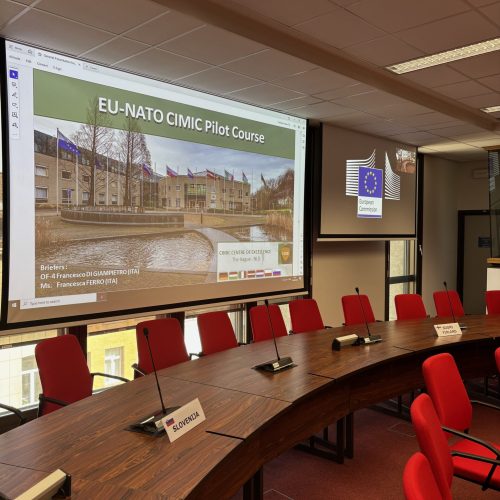
The initiative builds on the CCOE’s evolving role within the European security landscape. Appointed in 2017 as the EU Discipline Leader for CIMIC by the European Union Military Committee, and later accredited in 2020 as a Training Provider for the European Security and Defence College, the CCOE has emerged as a central hub for the development, promotion, and dissemination of CIMIC knowledge within the European Union. At the same time, the CCOE had long been firmly embedded within NATO structures, as Department Head for the CIMIC discipline, custodian of the AJP- 3.19, and as an accredited NATO Education and Training Facility. With this dual institutional identity in place, the CCOE was uniquely positioned to design a course capable of serving the needs of both frameworks, while preserving their respective mandates and approaches.
The course responds to growing operational demands and structural shortcomings in EU CIMIC training. Indeed, the EU CIMIC doctrine, last updated in 2008, no longer reflects today’s challenges. The 2023 Training Requirements Analysis Report further highlighted the need for a renewed investment in CIMIC education, pointing to significant gaps in doctrinal coherence, institutional awareness, and access to hands-on training. It was in light of these findings that the CCOE initiated the development of a new, forward-looking training programme.
The EU-NATO CIMIC
Course has been designed to offer participants a structured, progressive, and immersive learning experience. It employs a blended learning methodology, beginning with a preparatory e-learning phase to establish a common conceptual foundation. The in- person residential phase, hosted at the CCOE in The Hague, progresses from conceptual theory to operational application. The course opens with a comparative overview of EU and NATO CIMIC frameworks and doctrines, enabling participants to develop a shared vocabulary and mutual understanding. It then delves into the operational landscape, addressing topics such as hybrid threats, legal frameworks, institutional coordination, planning processes, and the instruments available within both the EU and NATO. The course culminates in a mission planning workshop and a scenario-based wargame exercise, allowing participants to translate the knowledge acquired into action within simulated, realistic environments.
Beyond training purposes, the course is conceived as a platform for dialogue, professional exchange, and institutional bridge-building. It aims to foster interoperability between EU and NATO actors, promote a shared strategic mindset, and cultivate the institutional synergies necessary to address today’s multidimensional crises. Rather than merging frameworks, the course facilitates constructive convergence, offering tools for collaboration that acknowledge and navigate institutional distinctions.
The course was formally presented to the Executive Academic Board of the European Security and Defence College in Brussels on 12 June 2025, where it received unanimous approval. This endorsement not only validates the academic and practical quality of the programme but also reflects a growing recognition of the importance of cross-institutional training in the field of CIMIC. The first pilot delivery is scheduled for 2026 and, as preparations advance for the first iteration, the EU-NATO CIMIC Course stands as a symbol of innovation and strategic foresight, marking the beginning of a new chapter in the evolution of comprehensive, policy-informed CIMIC training across Europe and beyond.
Support to UKR CIMIC
The CCOE continues to support the conventional and specialized CIMIC forces of the Ukrainian Armed Forces, including personnel from the Territorial Defense Forces of Ukraine, in close cooperation with other NATO member states, including the United Kingdom, Poland, Belgium, and the United States of America. This support is delivered through a two-week training program that includes both theoretical instruction and practical application, culminating in a tactical exercise. Ukrainian CIMIC staff are trained at the tactical level to operate effectively as CIMIC field personnel and staff officers.
While operational units deliver practical support during the tactical exercise, the CCOE provides the theoretical foundation and guidance based on NATO CIMIC and broader NATO doctrine.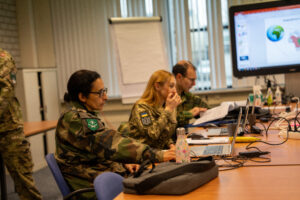
For over three years, the CCOE has consistently delivered instructor support to ensure that core NATO CIMIC knowledge is embedded within the Ukrainian CIMIC structures, from tactical units to battalion-level staffs, enabling their effective contribution to military operations. This commitment has been evident in all previous iterations of the training and will continue in future ones as part of NATO’s enduring support to Ukraine, both now and in the future.
In addition to this comprehensive training program, Ukrainian CIMIC personnel continue to regularly attend CCOE courses. These courses further enhance their capabilities at both tactical and operational levels by providing up-to-date NATO CIMIC doctrine, tools, and hands-on instruction.
Support to the NATO CIMIC Orientation Course (NCOC) at the NATO School Oberammergau
From 10 to 14 March 2025, the CCOE supported the NATO School Oberammergau (NSO) in conducting of the NATO CIMIC Orientation Course (NCOC).
The objective of the NCOC is to enhance the knowledge and understanding of NATO Civil- Military Cooperation (CIMIC) among non-CIMIC personnel, highlighting its relevance in daily staff functions and operational environments. While the course is organized and conducted by the NSO, the CCOE plays a vital role by providing subject matter expertise and developing the course programme and content – being as department head (DH) overall responsible for CIMIC education and training within NATO in order to ensure the curriculum reflects current NATO doctrinal developments and requirements.
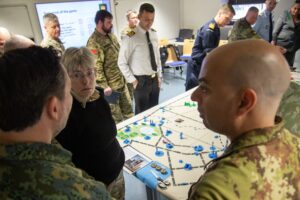
The course, attended by 25 military and civilian participants from various NATO and partner nations, introduced core concepts of CIMIC, including its designation as a NATO Joint Function. Through a blend of lectures, guided discussions, and practical applications, the course covered topics such as MDO, RtCP, Cross Cutting Topics (CCTs) and the core activities of Civil Factor Integration and Civil-Military Interaction.
Interactive tools such as the Analysia and WISE-AEGIS wargaming platforms were employed to reinforce learning outcomes and facilitate participant engagement in realistic scenarios.
Looking ahead, the CCOE will continue its cooperation with NSO by further developing course content and supporting the delivery of two additional iterations of the NCOC in 2026.
Training & Education at the CCOE: Enabling CIMIC Excellence Across NATO and Beyond
The CCOE has continued to serve as a cornerstone in the development and dissemination of NATO CIMIC knowledge, doctrine, and practice. With an enduring commitment to quality, interoperability, and innovation, the Training & Education branch has successfully delivered a wide range of training activities, reaching both NATO and partner nations.
In the first half of 2025 alone, the CCOE trained a total of 208 participants through its in- house and satellite courses. Delivered both at the CCOE in The Hague and in Sponsoring Nations, these programs ensured that CIMIC professionals are equipped with the theoretical foundations, operational insights, best practices and practical tools required for effective performance in multinational operations.
The CCOE’s Mobile Training Teams (MTTs) effort, predominantly reenforcing and supporting effectively the mobile training teams from NATO command structure, continued to play a vital role in delivering tailored instruction directly to NATO and partner nations. These teams supported national-level CIMIC training efforts and provided rapid, mission-focused education in preparation for operational deployments. The support of MTTs is mainly focusing on UKR CIMIC personnel.
The CCOE maintained a strong cooperative relationship with U.S. Civil Affairs, engaging in shared training initiatives and exchange of best practices. The instructor support exchange have improved interoperability, mutual understanding and aligns CIMIC and Civil Affairs doctrinal framework and best practices.

The CCOE also sustained its support to exercises of Sponsoring Nations and major NATO exercises. By integrating CCOE instructors and observers into these exercises, the CCOE provided doctrinal guidance, evaluated CIMIC performance, and offered targeted feedback to improve future training cycles and doctrinal developments.
Continuous Improvement and Innovation
In line with its commitment to excellence, the CCOE has implemented a continuous improvement cycle for all courses. Feedback from students and instructors is systematically analysed to enhance curriculum design, update content to reflect doctrinal developments, and incorporate real-world lessons learned. This ensures that CCOE courses remain at the forefront of NATO’s education and training efforts.
Furthermore, the integration and development of wargaming and scenario-based learning has significantly enhanced the realism and interactivity of CCOE training. These tools allow participants to apply knowledge in dynamic, pressure-tested environments that simulate operational complexity, bridging the gap between theory and practice.
